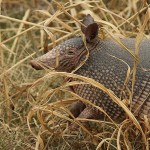Armadillos like to come out to forage in the late afternoon. This one had made his way onto a dirt parking lot which left him well exposed for photographs. Armadillos are not the most attractive animals on the planet, but the warm rays of the setting sun paint them in their best light.

Here is what Wikipedia has to say about our friend the Armadillo:
Armadillos are New World placental mammals with a leathery armor shell. The Dasypodidae are the only surviving family in the order Cingulata, part of the superorder Xenarthra, along with the anteaters and sloths. The word armadillo means “little armored one” in Spanish. The Aztecs called them āyōtōchtli, Nahuatl for “turtle-rabbit”: āyōtl (turtle) and tōchtli (rabbit).
About 10 extant genera and 20 extant species of armadillo have been described, some of which are distinguished by the number of bands on their armor. Their average length is about 75 cm (30 in), including tail. The giant armadillo grows up to 150 cm (59 in) and weighs up to 59 kg (130 lb), while the pink fairy armadillo is a diminutive species, with an overall length of 12 to 15 cm (5 to 6 in). All species are native to the Americas, where they inhabit a variety of environments.
Like all other xenarthran lineages, armadillos originated in South America. Due to the continent’s former isolation, they were confined there for most of the Cenozoic. The recent formation of the Isthmus of Panama allowed a few members of the family to migrate northward into southern North America by the early Pleistocene, as part of the Great American Interchange. (Some of their much larger cingulate relatives, the pampatheres and glyptodonts, made the same journey.)
Today, all extant armadillos species are still present in South America. They are particularly diverse in Paraguay (where eleven species exist) and surrounding areas. Many species are endangered. Some, including four species of Dasypus, are widely distributed over the Americas, whereas others, such as Yepes’s mulita, are restricted to small ranges. Two species, the northern naked-tailed armadillo and nine-banded armadillo, are found in Central America; the latter has also reached the United States, primarily in the south-central states (notably Texas), but with a range that extends as far east as South Carolina and Florida, and as far north as Nebraska and midwestern Kansas. Their range has consistently expanded in North America over the last century due to a lack of natural predators. They have been found as far north as southern Illinois






